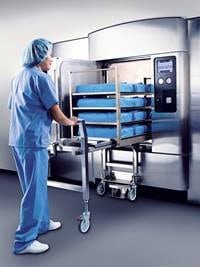 As the major endoscope manufacturers continue to work with regulators such as The United States Food and Drug Administration (FDA) to improve the safety of their endoscopes, many possible long-term solutions have been raised for discussion. Some thought leaders say that improving current high-level disinfection (HLD) processes will improve safety significantly, while many other experts are advocating for the use of disposable endoscopes or endoscopes with disposable components to increase patient safety. Many others have pushed toward a standard of using sterilization to reprocess endoscopes instead of HLD. While all of these ideas have merit, they have their own pros and cons related to feasibility, cost and convenience.
As the major endoscope manufacturers continue to work with regulators such as The United States Food and Drug Administration (FDA) to improve the safety of their endoscopes, many possible long-term solutions have been raised for discussion. Some thought leaders say that improving current high-level disinfection (HLD) processes will improve safety significantly, while many other experts are advocating for the use of disposable endoscopes or endoscopes with disposable components to increase patient safety. Many others have pushed toward a standard of using sterilization to reprocess endoscopes instead of HLD. While all of these ideas have merit, they have their own pros and cons related to feasibility, cost and convenience.
The challenges of endoscope sterilization are numerous. Many endoscopes aren’t approved for sterilization, for one. Sterilization also can be hazardous to staff due to exposure to the sterilization chemical ethylene oxide. Lastly, sterilization can end up being a more costly process per scope and can present logistical challenges to complete. While not all scopes can currently go through sterilization, hospitals should decide if sterilization does make sense for a subset of their scopes. Scope hygiene expert Lawrence F. Muscarella, PhD has proposed the adoption of a 3 tier classification system for determining which scopes are good candidates for sterilization. As this article by Alison McCook at Gastroenterology & Endoscopy News summarizes:
“Given that sterilizing all scopes is not feasible, Dr. Muscarella said facilities should determine which scopes they are able to sterilize, and those that are most likely to remain contaminated following reprocessing that includes high-level disinfection. The latter group of instruments—which he argued includes duodenoscopes and any other scopes that data show can carry contamination or contain complex moving parts, such as linear-array echoendoscopes—belong in his scheme’s group 1.
Group 2 devices are those that still can transmit dangerous infections but are simpler in design and easier to properly clean, according to Dr. Muscarella, and may include cystoscopes, ureteroscopes, gastroscopes and colonoscopes. These types of tools can be reprocessed using high-level disinfection, although facilities ideally should try to phase in sterilization, he added. Until that time, he recommended adopting one of the FDA’s other supplemental techniques to monitor scope safety, such as repeating high-level disinfection and/or taking cultures to check for contamination.
Group 3 scopes such as hysteroscopes and transthoracic echocardiography probes generally have a low likelihood of transmitting dangerous infections if properly cleaned, and can be reprocessed according to the manufacturers’ instructions. If persistent contamination with bacteria or damage is suspected, however, sterilization or adoption of one of the FDA’s other recommended supplemental measures may be necessary.
Dr. Muscarella said the goal of his protocol is to provide facilities advice they could feasibly follow as they try to increase their use of sterilization. “It seems different scopes are associated with different risks,” he said.
“What I wanted to do was develop a scheme that is more evidence-based; adopts a ramp-up model, rather than requiring an abrupt change in practice; and can be phased in over time without either as much disruption or placing patients at risk.”
Read the entire article here: Which Flexible Scopes Really Need Sterilization?
As evidence continues to mount about the potential dangers of flexible endoscopes such as duodenoscopes, hospitals must ensure that they’re doing everything they can to protect themselves and their patients from harm. Dr. Muscarella rightly points out facilities should consider if it makes sense to move some endoscopes to sterilization for their reprocessing protocol. Whether reprocessing using HLD or sterilization, make sure that your staff is following the proper processes and protocols each and every time an endoscope is reprocessed. Systems such as iRIScope can display the proper workflow for reprocessing scopes such as duodenoscopes and document the process in real-time. Any breaches of protocol can be alerted in real-time to protect patients and identify which staff members need additional training on reprocessing techniques. You owe it to your staff and your patients to offer everyone the peace of mind that your flexible endoscopes are being properly reprocessed every single time.
